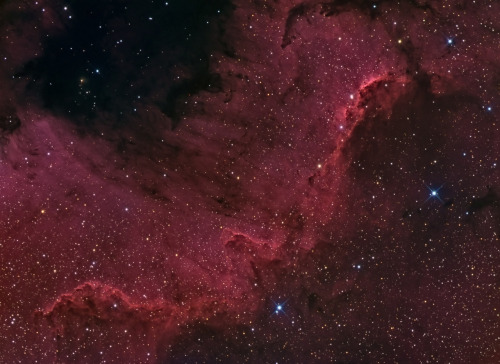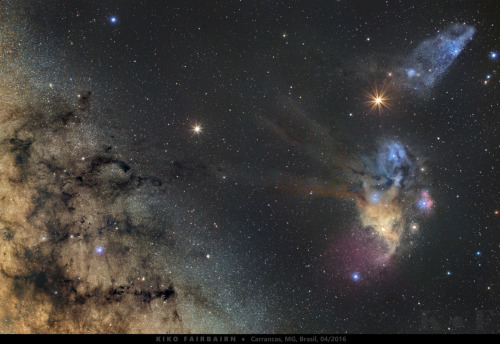Panorama From The Apollo 15 Mission

Panorama from the Apollo 15 mission
More Posts from Littlecadet-biguniverse and Others

Southern NGC7000
js

Philae found!
Less than a month before the end of the mission, Rosetta’s high-resolution camera has revealed the Philae lander wedged into a dark crack on Comet 67P/Churyumov–Gerasimenko. The images were taken on 2 September by the OSIRIS narrow-angle camera as the orbiter came within 2.7 km of the surface and clearly show the main body of the lander, along with two of its three legs. The images also provide proof of Philae’s orientation, making it clear why establishing communications was so difficult following its landing on 12 November 2014. Philae was last seen when it first touched down at Agilkia, bounced and then flew for another two hours before ending up at a location later named Abydos, on the comet’s smaller lobe.After three days, Philae’s primary battery was exhausted and the lander went into hibernation, only to wake up again and communicate briefly with Rosetta in June and July 2015 as the comet came closer to the Sun and more power was available. The discovery comes less than a month before Rosetta descends to the comet’s surface. On 30 September, the orbiter will be sent on a final one-way mission to investigate the comet from close up, including the open pits in the Ma’at region, where it is hoped that critical observations will help to reveal secrets of the body’s interior structure.
Credit: ESA

Saturn and Mars visit Milky Way Star Clouds
js

47 Tucanae

Galaxy Trio Arp 286:
NGC 5566 (bottom), NGC 5569 (left), & NGC 5560 (center)

Nebula NGC 3603
js

TODAY IN HISTORY: The spectacular rings of Saturn, August 23, 1981, observed by the Voyager 2 space probe.

Our Moon along with Jupiter and it’s 4 largest moons.
Image Credit & Copyright: Cristian Fattinnanzi

Solar filaments a.k.a. prominences – when observed at the solar limb (above), are long clouds of partially ionized plasma suspended above the Sun’s surface by strongly sheared magnetic structures, called filament channels, that can support the dense plasma against solar gravity. Filaments may form at various locations on the Sun, however, they are always found within preexisting filament channels above polarity inversion lines which separate areas of opposite magnetic polarity regions.
Credit: NASA/SDO/LMSAL
-
 bikerdude51 liked this · 6 years ago
bikerdude51 liked this · 6 years ago -
 mar-16tr liked this · 7 years ago
mar-16tr liked this · 7 years ago -
 theoldarmor liked this · 7 years ago
theoldarmor liked this · 7 years ago -
 mecha3 reblogged this · 7 years ago
mecha3 reblogged this · 7 years ago -
 ashismybop-blog liked this · 7 years ago
ashismybop-blog liked this · 7 years ago -
 magnoliavoltz liked this · 8 years ago
magnoliavoltz liked this · 8 years ago -
 unobservable-universe-blog reblogged this · 8 years ago
unobservable-universe-blog reblogged this · 8 years ago -
 starshine-sunlight-blog liked this · 8 years ago
starshine-sunlight-blog liked this · 8 years ago -
 marshmallowmami reblogged this · 8 years ago
marshmallowmami reblogged this · 8 years ago -
 marshmallowmami liked this · 8 years ago
marshmallowmami liked this · 8 years ago -
 struggling-photographer liked this · 8 years ago
struggling-photographer liked this · 8 years ago -
 in-your-tp liked this · 8 years ago
in-your-tp liked this · 8 years ago -
 gentlemannonconformist liked this · 8 years ago
gentlemannonconformist liked this · 8 years ago -
 mind-of-matsui liked this · 8 years ago
mind-of-matsui liked this · 8 years ago -
 stormfighter6 liked this · 8 years ago
stormfighter6 liked this · 8 years ago -
 youraveragepun liked this · 8 years ago
youraveragepun liked this · 8 years ago -
 cielaestrada liked this · 8 years ago
cielaestrada liked this · 8 years ago -
 tobyvansten reblogged this · 8 years ago
tobyvansten reblogged this · 8 years ago -
 unicorn-queen0414 liked this · 8 years ago
unicorn-queen0414 liked this · 8 years ago -
 daniele-piccioni liked this · 8 years ago
daniele-piccioni liked this · 8 years ago -
 oh-sarahjane liked this · 8 years ago
oh-sarahjane liked this · 8 years ago -
 unmoogled reblogged this · 8 years ago
unmoogled reblogged this · 8 years ago -
 littlecadet-biguniverse reblogged this · 8 years ago
littlecadet-biguniverse reblogged this · 8 years ago -
 ostentatiousrrex liked this · 8 years ago
ostentatiousrrex liked this · 8 years ago -
 retrograde0 liked this · 8 years ago
retrograde0 liked this · 8 years ago -
 set-saiil liked this · 8 years ago
set-saiil liked this · 8 years ago -
 candylani18 reblogged this · 8 years ago
candylani18 reblogged this · 8 years ago -
 candylani18 liked this · 8 years ago
candylani18 liked this · 8 years ago -
 easley1024 liked this · 8 years ago
easley1024 liked this · 8 years ago -
 renownlessprincess liked this · 8 years ago
renownlessprincess liked this · 8 years ago -
 terryphoo liked this · 8 years ago
terryphoo liked this · 8 years ago -
 thethingaboutfantasy reblogged this · 8 years ago
thethingaboutfantasy reblogged this · 8 years ago -
 theforgettableheart liked this · 8 years ago
theforgettableheart liked this · 8 years ago -
 jaime382 liked this · 8 years ago
jaime382 liked this · 8 years ago -
 getthefuckoutofmyface reblogged this · 8 years ago
getthefuckoutofmyface reblogged this · 8 years ago -
 o-mikron liked this · 8 years ago
o-mikron liked this · 8 years ago
GREETINGS FROM EARTH! Welcome to my space blog! Let's explore the stars together!!!
144 posts
